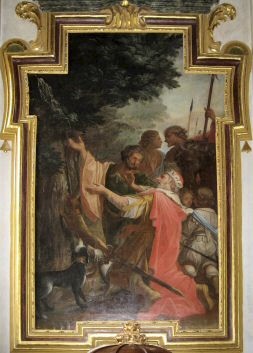Legend has it that Margrave Leopold III founded the monastery of Klosterneuburg on the spot where he found his wife's lost bridal veil on an elder tree. This report is completely unhistorical. The origin of the collegiate monastery remains obscure to this day. It is not even certain that it was founded by the Babenbergs, for in the early days there is evidence of relations between the monastery and noble families of Lower Bavaria, such as Count Walter von Chling. The date of the foundation is unknown. It may be assumed to have been founded somewhat before 1100, unless one adheres to the unproven and hardly tenable assumption that the collegiate monastery of Deutsch-Altenburg-Hainburg, founded by Emperor Heinrich III in 1051, was transferred to Klosterneuburg.

Leopold III finds the veil, Jesuit Church Vienna
However, it is certain that the monastery of Klosterneuburg was owned by Margrave Leopold III: he endowed it with rich donations and built the present collegiate church, at that time the largest church in the country, on the site of an older church in 1114-1136. The Margrave may have initially set up his residence in the old city castle on the site of the old Roman fort (a Roman fort had existed in Klosterneuburg since the 1st century AD). When he then generously endowed and expanded the monastery, he probably already planned a new castle wing, today's monastery archives, for himself on this occasion. The sovereign residence and the monastery formed a single unit.
A turning point in the history of Klosterneuburg came in 1133 when the Margrave converted the collegiate monastery, which had been secular until then, into a monastery of regular canons (Augustinian canons). The impetus for this came from his son Otto, until then provost of Klosterneuburg, who had joined the newly founded, strict Cistercian order in Morimond. He and the Austrian bishops persuaded Leopold III to renounce his own ecclesiastical rights and his ecclesiastical policy plans and to make his residential monastery a centre of church reform. The monastery remained closely linked to the House of Babenberg. When Leopold III died in 1136, he was buried in the chapter house at Klosterneuburg, as was his wife Agnes, the daughter of Emperor Henry IV. Many descendants of the founding couple were also buried here.
Like all Augustinian canons' monasteries in the High Middle Ages, Klosterneuburg Abbey was a double monastery, as there was a monastery for canonesses in addition to the monastery for men (this only died out in 1568). The monastery was not only under papal protection, but was also always a place of care for a strictly ecclesiastical spirit. Hand in hand with this went a lively cultural activity: the manuscripts written and illuminated in the monastery, the annals written, the theological activity of the canons and, last but not least, a whole series of exquisite works of art, the most famous of which is the enamel altar of Nicholas of Verdun, completed in 1181, bear eloquent witness to this.
Ever since Leopold III had given Klosterneuburg a very rich present, the sovereigns had turned their favour to the monastery. They held the patronage of the monastery.
Donations and privileges secured the material existence of the monastery. New splendour came to Klosterneuburg when Duke Leopold VI moved his residence here soon after taking office at the end of the 12th century. He magnificently extended the old city castle of Leopold III and had the "Capella Speziosa" built as a castle chapel, the first work of Burgundian Gothic architecture in our homeland. In 1216, the duke's eldest son Leopold had a fatal accident at the monastery school in Neuburg, where he was receiving instruction. Soon afterwards Leopold VI moved his court residence back to Vienna, and another glorious era came to an end for Klosterneuburg. The monastery also experienced economic difficulties. The end of the Babenbergs also meant the end of a happy period for Klosterneuburg. It was not until the 14th century that the monastery was able to flourish again.
Source: Catalogue of the Lower Austrian Provincial Exhibition 1976 "1000 Years of the Babenbergs in Austria".